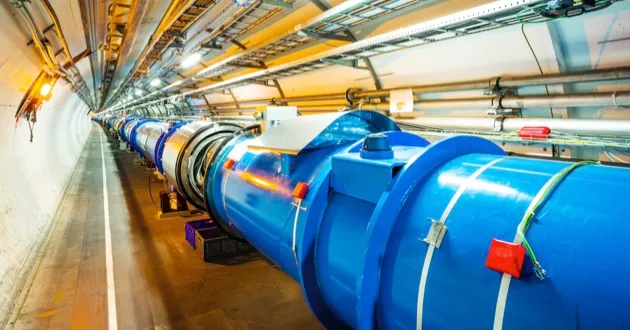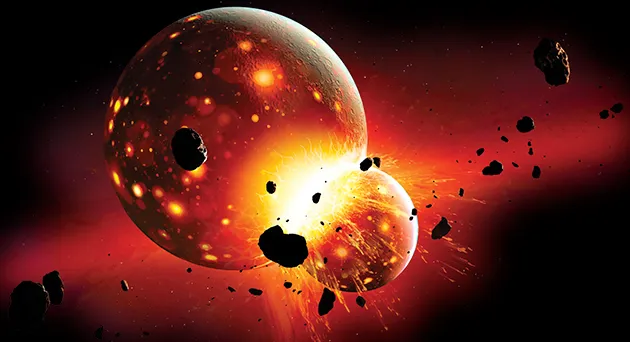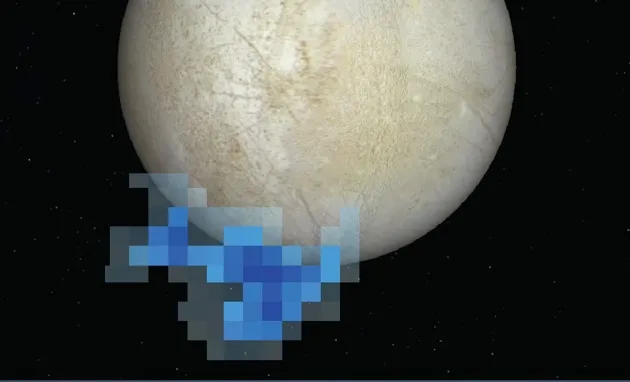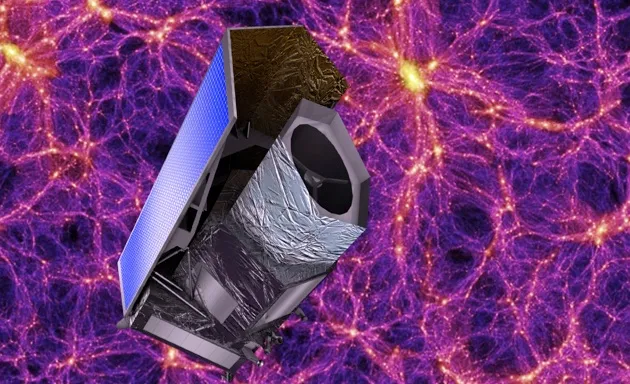1. How did it all begin?
Cosmologists talk about the Big Bang, but they have no idea what it was. “We are sure that the early phase of the Universe was hot and dense,” says Prof Tim O’Brien, an astronomer from Jodrell Bank, University of Manchester. “But what triggered the Big Bang is still very much open for investigation.”
In March 2014, astronomers using an instrument called BICEP2 thought that they had seen evidence for a colossal increase in the expansion of the Universe at the moment of the Big Bang. This would fit theoretical ideas called inflation. Sadly, it turned out to be space dust contaminating the signal.
2. What are fast radio bursts?
Fast radio bursts have the whole radio astronomy community scratching their heads at the moment. Just a dozen or so of the mysterious electromagnetic pulses have been discovered since the first one was detected in 2001. Each lasts just a few milliseconds, yet carries as much energy as the Sun releases in a month.
“We really have no idea at all what these things are,” says O’Brien.
Various suggestions have been made, including exploding stars, evaporating black holes and even alien signalling devices.
Calculations show that there could be as many as 10,000 of these radio bursts taking place every single day, but they still remain a mystery.
3. What is the space time continuum?
“The space-time continuum is the pinnacle of cosmological achievement in the last century,” says Dr Andrew Pontzen, cosmologist at University College London. The trouble is, nobody understands what it actually is. When Einstein developed General Relativity, he introduced it as a mathematical coordinate system. But what did it represent in reality?
The maths suggested it was a malleable substance in which the celestial objects are suspended, but General Relativity provides no real insight into its physical nature. It could be made of incredibly tiny particles like a beach, which looks smooth from a distance but on close-up examination can be seen to be made from grains of sand. If so, it would need a quantum theory of space-time to be developed.
There are some indications that light from distant stellar explosions, known as gamma-ray bursts, are delayed according to their wavelength as they travel across space. This is important because space-time particles would slow down shorter wavelengths of light more than longer wavelengths.
There have been too few observations to prove or disprove the quantum nature of space-time. The puzzle remains: what is the space-time continuum?
4. What is dark matter?
Almost every galaxy that astronomers have currently studied spins faster than they can explain. This means that there must be some other source of mass that we are unable to directly detect.
Unfathomable galactic motions first came to light in the 1930s thanks to the work of Swiss astronomer Fritz Zwicky. He postulated that the extra mass must come from an unseen gas. He called this gas ‘dark matter’.
By the 1970s, the need for dark matter was worse than ever. Astronomers were seeing far too much movement in the individual galaxies, yet they were convinced that the dark matter could not be atoms otherwise they would have found it already. Particle physicists provided a possible solution because they were predicting relic particles of nature that are invisible to light but interact through gravity.

“We are now at a point where a lot of experiments on Earth stand a realistic chance of seeing something,” explains Pontzen. One of those experiments is the newly upgraded Large Hadron Collider at CERN, which is now looking for neutralinos. These are currently the best candidate particles for dark matter, but are only hypothetical. If CERN does not find them, it will be back to the drawing board.
Could a hidden world of dark matter exist right under our noses?
5. How did the moon form?

The origin of the Moon has proven remarkably tricky for astronomers to understand. In the late 1990s, planetary geologists felt that they had finally zeroed in on the answer. They called it the ‘Big Splat’.
The idea involves a world about the size of Mars striking the Earth a glancing blow so that the shattered world gathered in Earth’s orbit. Once there, the debris coalesced to form the Moon. Moon rocks brought back by the Apollo astronauts corroborated this scenario. But then it all went wrong.
Better measurements showed that the Moon’s rocks were not just similar to Earth’s rocks – they were virtually identical. This would not be the case if the Moon had mostly formed out of the impactor.
“The giant impact is still the best hypothesis because all the other scenarios just seem impossible,” explains planetary scientist Prof David Rothery from the Open University.
Currently, researchers are wondering whether a scenario can be envisaged in which the impacting body is smaller and embeds itself in Earth, blasting out rocks to form the Moon.
Has Earth ever had more than one moon?
6. Do we understand gravity?
Many scientists are convinced we need a new theory to explain the strongest gravitational fields in the Universe. But a much smaller group thinks that a new theory of gravity is also needed to explain very weak gravitational fields.
The idea is called Modified Newtonian Dynamics (MOND). It was developed in the 1980s by the Israeli physicist Mordehai Milgrom. He made a small mathematical modification to Newton’s Universal Law of Gravitation and showed that it could reproduce the rotation of galaxies without the need for dark matter. Yet no-one knows why such a modification should exist.
ESA’s LISA-Pathfinder mission could help. The craft is designed to test sensitive instrumentation in the study of gravity in space. It launched in December 2015 and once the payload has been shown to work, the craft could be sent on a journey to test MOND in a region between Earth and the Sun. LISA-Pathfinder is sensitive enough to show if the weak gravity there is following Newton’s or Milgrom’s prediction. If Newton rules, there must be dark matter. If Milgrom gets it right, he’s looking at a Nobel Prize.
Will we ever be able to control gravity?
7. What makes a planet habitable?
Before we can go looking for habitable planets in the Universe, we first have to know what makes a planet capable of supporting life. This is no easy task. There are a number of factors that determine whether a planet can support life.
Astronomers often talk about the habitable zone: the region around a star in which a planet can be warm enough for liquid water to exist on its surface. However, as Europa proves, this might be too simplistic.
“I no longer think about a habitable zone,” says Dr Peter Grindrod, a planetary scientist at Birkbeck, University of London. “Instead, I think planetary zones can be much more localised.”

What seems clear is that there needs to be an energy source and nutrients, then water or some other solvent in which the biochemistry can take place. In terms of ‘life as we know it’, this means we should look anywhere there is abundant water and sunlight.
But there could be other possible biochemistries as well. A key investigation for theoretical astrobiology is to identify other routes to life as well. Such research has the potential to drastically change the way we think about planetary habitability.
Beyond Earth, what's the most likely site of life?
8. What are black holes?
“We’re sure they exist, even though we’ve never seen one,” says O’Brien. Black holes are the places in the Universe where matter has become so condensed that gravity has become overwhelming. No amount of energy will allow you to escape from a black hole once you cross its outer boundary, known as the event horizon (although Professor Stephen Hawking recently announced a different theory).
Light cannot escape either, making them appear black. They are often very small too, which means they are fiendishly difficult to spot. To put this in context, to transform the Earth into a black hole, it would need to be squeezed into a sphere about one centimetre across.
However, the real mystery of black holes is what lies inside them. Nothing in physics appears able to stop the matter collapsing into a denser and denser object until it reaches a point of infinite density in zero volume, known as a singularity. But mathematically, a singularity seems almost impossible. “I find it very hard to believe a singularity can exist in nature,” says O’Brien.
Our predominant theories of physics – General Relativity and quantum mechanics – are no help here. Worse, the hints these theories do give are contradictory. Physicists are currently trying to develop ‘quantum gravity’. This is a mathematical theory that could give us testable predictions about the true nature of black holes. For now, we’re stumped.
Could black holes be portals into other universes?
9. Is there life on Europa?
Europa is one of the four moons of Jupiter spotted by Galileo in 1610. At the time, the discovery caused a sensation, with some wondering why such a world had been placed into the heavens. Yet it wasn’t until space probes took close-up observations in the 1970s that Europa’s true mystery came to light.
Its neighbouring moon, Io, suffers from giant eruptions that throw sulphurous lava high into space. This volcanic activity is sustained by a gravitational tug-of-war that sees Jupiter pulling the moon one way, and the other moons pulling it the other. On Europa, these forces are not so severe. They cannot spark volcanism, but they can keep the moon’s interior warm enough to melt much of the ice. Europa’s ocean is so large that it must contain two to three times more water than all the oceans on Earth put together.

On Earth, one theory states that life started on the dark ocean floor around hydrothermal vents called black smokers. Black smokers occur when water heated in the interior of our planet jets up into the ocean. The water carries dissolved chemicals that provide nutrients for the ecosystem’s exotic microorganisms. Could the same be happening on Europa? Prof David Rothery, a planetary scientist at the Open University, thinks it’s a distinct possibility. He says: “Europa is one of the most promising places to look for life. It has everything you need.”
NASA’s Europa Clipper mission will determine whether Europa possesses the right conditions for life. There is no precise launch date, but NASA expects it to be on its way in the 2020s. In 2016, $30m (£19m approx) will be spent developing the craft and its instruments.
In 2012, the Hubble Space Telescope spotted water vapour around the moon’s south pole, implying that the ice is thin or fissured, allowing the subsurface water to escape. Planetary geologists have seen cracks appearing on Europa because of the gravitational forces that are at work. All this means that Europa Clipper could directly sample the water by flying through these plumes. Maybe it could look for the evidence of life?
“Once you are at Europa, it is easier to look for life than at Mars,” says Rothery. This is because any microbes that have formed in the ocean could find themselves transported to the bottom of the ice crust on the rising currents, and then jetted through the cracks, bringing them to the surface where they could be studied.
Assuming that the signs remain positive for life, a follow-on mission could be designed to land on the icy surface and burrow down into the ocean below.
10. What is dark energy?
When it comes to a list of cosmic unknowns, there is no question about what tops the list. “Dark energy is certainly the biggest mystery in our understanding of the present day Universe,” says Pontzen.
In 1929, US astronomer Edwin Hubble established that distant galaxies are moving away from us. Belgian astronomer Georges Lemaître had predicted this behaviour in 1927, when he calculated the expected rate of this expansion. Rather unjustly, this is now called the Hubble Constant.
By the 1990s, the Hubble Space Telescope was in orbit and was being used with ground-based telescopes to measure the rate at which this expansion changed across the breadth of the observable Universe. Two international research teams were racing to make this measurement as it would reveal the fate of the Universe: whether it would expand forever or fall back together, coming to an end in a catastrophic ‘Big Crunch’.
It seemed obvious that the expansion must be decelerating, because the gravity generated by the matter in the Universe would resist the expansion. What the teams discovered was the complete opposite – the expansion is getting faster. Further research has shown that the acceleration began about seven billion years ago, when the Universe was about half its current age.
It is as if some previously undetected anti-gravity substance is dominating the behaviour of the Universe. It makes up about 70 per cent of all the matter and energy in the cosmos, and is called ‘dark energy’. Yet uncovering its identity remains very difficult. “Frankly, we are still pretty clueless,” says Pontzen.
There are two leading possibilities: it is either an energy, or a force of nature. If it is an energy, then it will have to display properties unlike any other energy. Some people call it negative energy, because instead of generating gravity, it creates a kind of anti-gravity. If it is a force, often termed ‘quintessence’, then it is very weak. But over the vastness of space, it builds up into the acceleration we see around us.

To try to discriminate between these two options, the European Space Agency is building a space telescope called Euclid. Launching in 2020, it will map galaxies to a distance of 10 billion light-years, to reveal the way dark energy has moved them around. It will allow cosmologists to describe the behaviour of dark energy, such as whether it changes from place to place.
Whatever dark energy turns out to be, it will require a re-write of the textbooks when we finally understand its true nature.
Stuart Clark holds a PhD in astrophysics and is author of The Unknown Universe.
This article has been edited for the web. The full version of this article appears in the August 2015 issue of BBC Focus magazine.